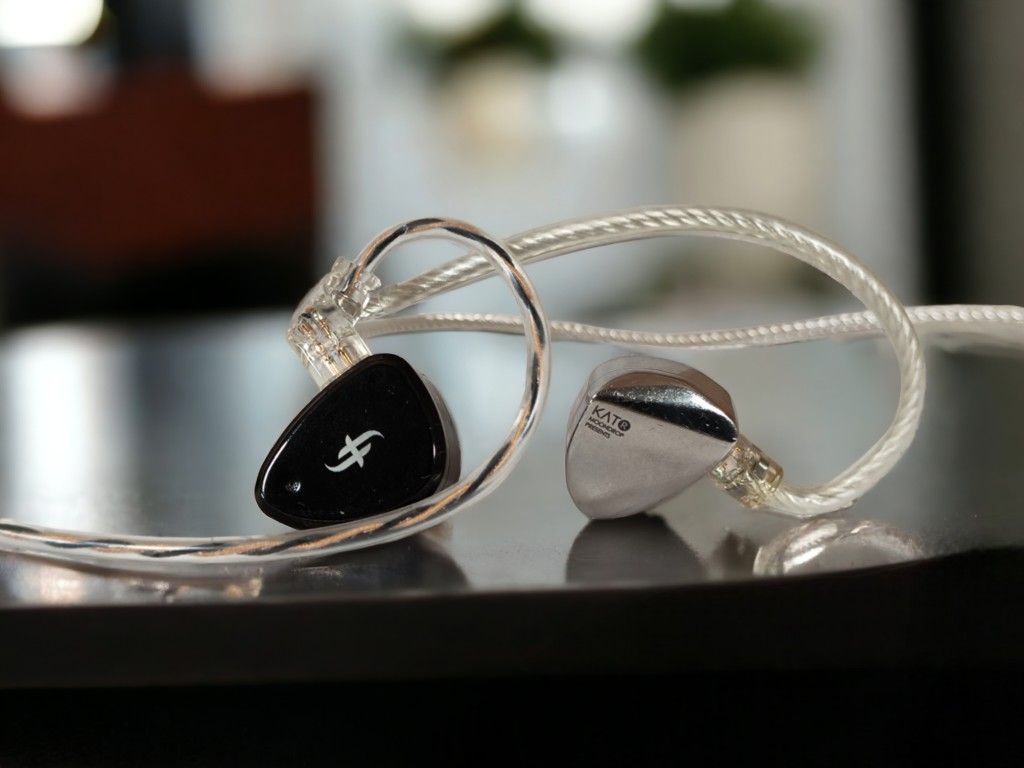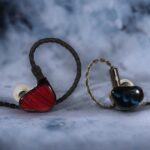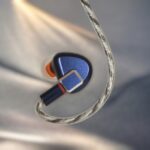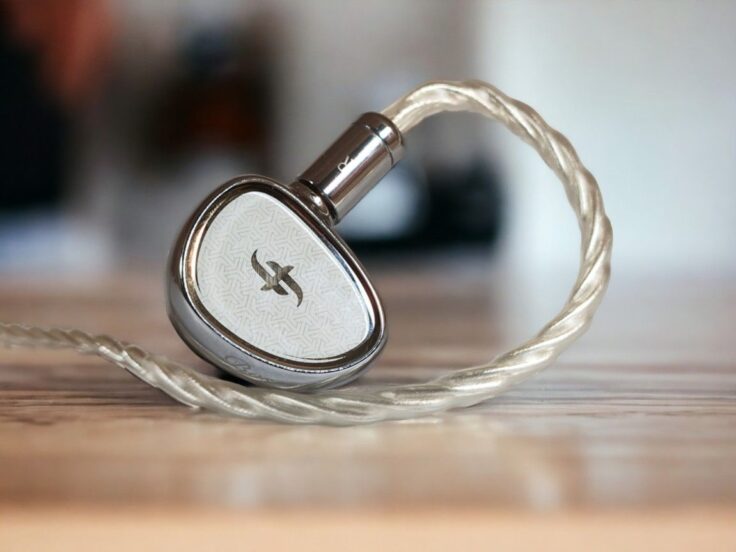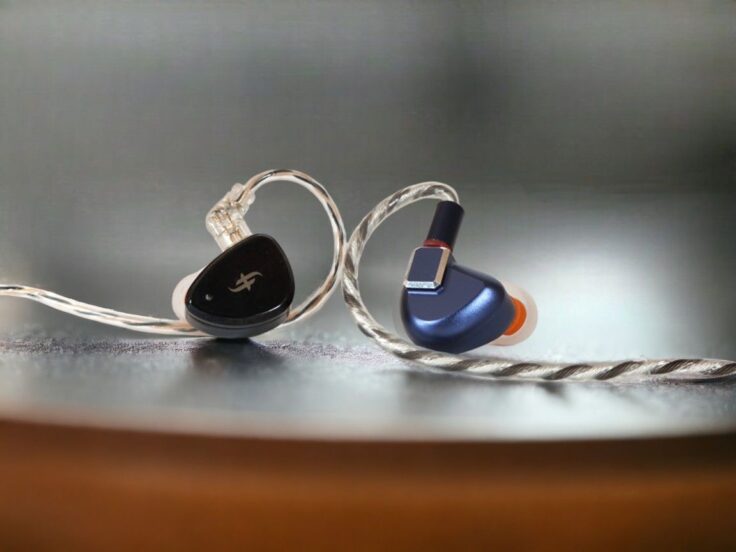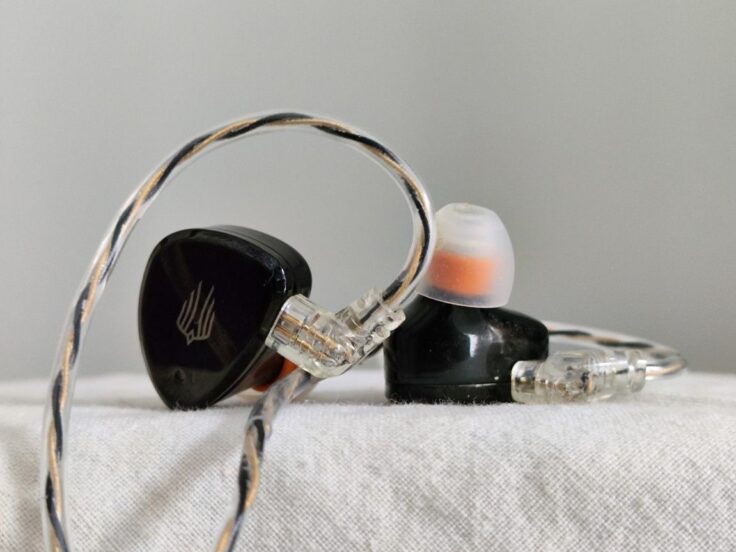The Moondrop Kato is a long-standing reference in its class. It sounds great, and it looks beautiful. The EM6L is a newcomer, but it has already gained a reputation for offering great sound at a good price, as well as having especially great imaging capabilities.
The Kato features a brass body that houses a single 10mm dynamic driver. The diaphragm is made of a composite material that includes DLC (Diamond Like Carbon) for increased rigidity and reduced weight.
Further, the Kato has replaceable nozzles and comes with two pairs: Steel and brass. They do not sound very different but the brass gives you a little bit more bass. I will stick to the steel nozzles for this review.
The EM6L has a total of five drivers per side: One dynamic driver (DD) and four balanced armature drivers (BA). The 8mm dynamic driver handles the bass and lower mids. It’s similar to the larger drivers of the EA1000 and EA2000). The upper mids are handled by a pair of balanced armature drivers, and do is the treble. There’s a three-way crossover.
The EM6L’s housing is very light and comfortable. It’s mostly made of resin and has a CNC-processed faceplate. The passive noise isolation is superb.
SIMGOT EM6L SPECIFICATIONS
- Drivers: 1 dynamic and 2 pairs of balanced armatures per side (1DD+4BA)
- Dynamic Driver: High-performance polymer composite diaphragm & dual-cavity driver
- Impedance: 26Ω±15%(@1kHz)
- Sensitivity: 119dB/Vrms(@1kHz)
- Frequency Response Range: 8Hz-40kHz
- Shell Material: High-precision 3D-printed resin
- Earphone Connector: Recessed 2 pin 0.78mm
- Cable: Detachable Silver-Plated OFC with 3.5mm termination
Price when reviewed: $109.99
- Price on Amazon: Simgot EM6L
- Price on Linsoul: Simgot EM6L
MOONDROP KATO SPECIFICATIONS
- Driver: Single 10mm-ULT dynamic driver
- Diaphragm: 3rd generation DLC composite diaphragm Impedance: 32Ω ±15%(@1KHz)
- Sensitivity: 123dB/Nrms (@1KHz)
- Distortion: < 0.15% (@1khz, AES17 20khz, A-weight)
- Socket: 0.78-2Pin sunken design
- Cable plug: 3.5mm stereo single-ended plug
- Frequency response range: 10Hz-45kHz
Price when reviewed 170 USD
- Price on Linsoul: Moondrop Kato
- Price on Amazon: Moondrop Kato
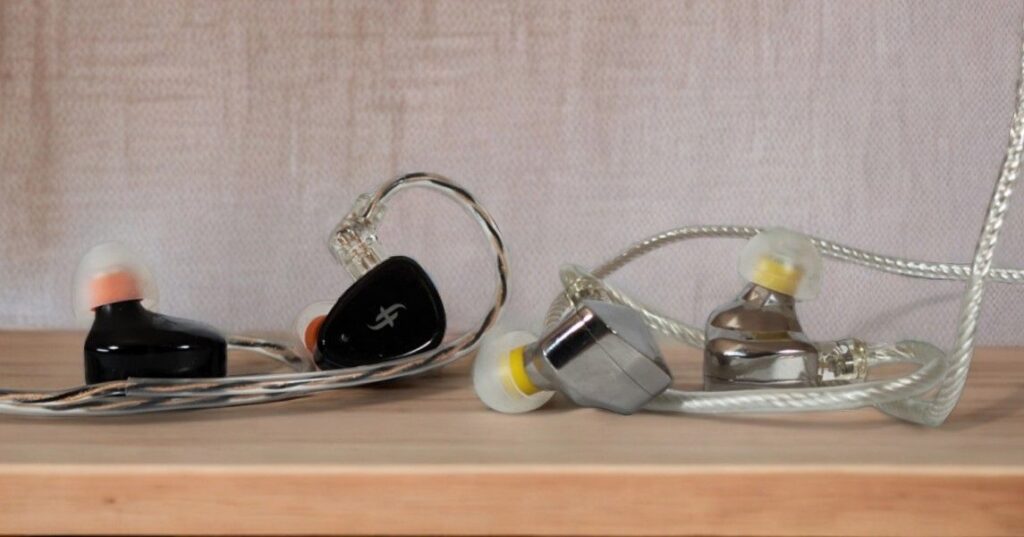
COMPARISONS
I used both the Rebel Amp and the Topping A90 amplifier The source was the RME ADI-2 DAC FS. The EM6L requires a bit more volume to reach the same listening level.
Tide of Trepidation by EST
Starting with the Topping A90 amplifier, the EM6L has a powerful bass and is very spacious. The imaging is stunning. With the Kato, everything sounds smoother and fuller, and the instruments get more body and soul. At the same time, it feels more detailed and nuanced. The imaging is, however, not as good as with the EM6L. With the Rebel Amp, the EM6L sounds warmer and lusher than with the Topping.
Farlig Norsk Hengebru by Moskus
This fun, jazzy track has lots of playful percussion. The imaging on the EM6L is superb. Everything sounds fast and snappy.
Switching to the Kato, however, there’s a big difference. The bass is fuller, all the instruments sound more true to life and natural. It sounds warmer. The EM6L sounds dry in comparison. With the Rebel Amp, the EM6L sounds smoother and better in every way. The imaging of the Kato, even though it is good, is not in the same league as the EM6L.
Jambi by Tool
The Kato sounds significantly fuller and meatier. The contrast is quite large. With the Topping A90, the EM6L has sharper edges, it sounds drier – but to a lesser degree with the Rebel Amp. However, the EM6L sounds fast and has superb imaging as always.
Smile by Pearl Jam
This is my sibilance test song, and the EM6L passes with ease. I expected it to be sibilant because it can have a bit of an edgy character, but I was proved wrong. I think the sound signature works well. The instruments and the vocals are nicely balanced. Nothing stands out too much but everything is present. The vocals are not recessed like they can be with other IEMs.
The Kato is not sibilant either, but it’s closer. Generally, it sounds a bit smoother, but they are more alike here than with the previous tracks.
As Before by Olga Konkova
The bass is nice and punchy with the EM6L, the piano is clear and crisp, and the vocals are clean and present. There is a great sense of spaciousness.
With the Kato, vocals are a bit less up front. The sound is a bit thicker, more organic, and liquid. The piano is very clear, and the cajôn drum is punchy.
Young Vivaldi Violin Concerto RV813-III by Ensemble Modo Antiquo
This fantastic-sounding string piece is quite good on the EM6L. However, it does have a slightly sharp and dry tone with the Topping A90 amp. The Kato sounds a lot smoother and has a better timbre. With the Rebel Amp, the EM6L sounds a bit warmer and smoother than with the A90, although the Kato is still better.
Richter: Summer 3 – Vivaldi Recomposed
The Kato sounds wonderful, a warm and natural presentation with great timbre across all instruments. Wonderful rendering of string instruments.
The EM6L sounds good too, but it’s less warm-sounding. Instruments have a thinner and sharper character. Again, the Rebel Amp does wonders for the EM6L and pushes it in the right direction, sounding slightly warmer and more detailed at the same time.
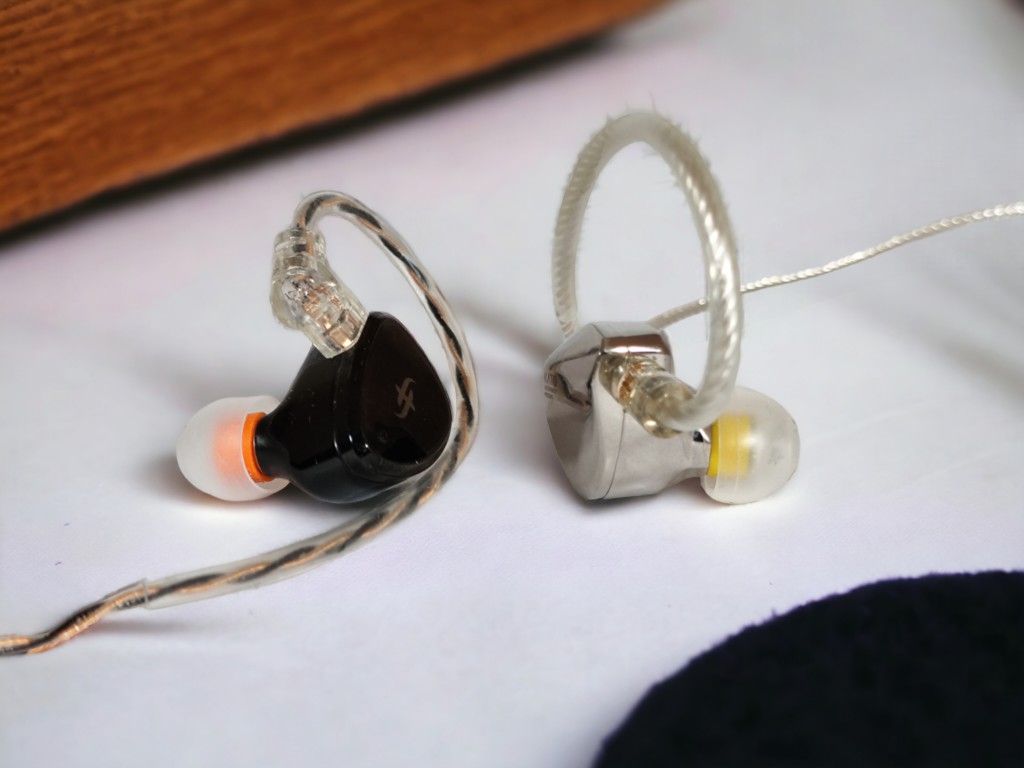
WRAPPING IT UP
Sound Signature
The EM6L is tuned somewhat towards the Harman 2019 target, however with an important elevation between 100 and 300 Hz in the upper bass region. The Moondrop Kato is relatively similarly tuned.
Treble
The EM6L has a clear treble that’s not too bright. It is a bit drier-sounding than the Kato, which, even though sometimes brighter, mostly feels more relaxed and nuanced.
Midrange
Compared to the Kato the EM6L midrange sounds thinner, with less body and warmth. However, the EM6L has great midrange clarity, while the Kato sounds thicker and fuller – although still with good amounts of detail.
Bass
The bass of the EM6L is very good. It’s strong and tight. There’s no unnecessary bloom or bleeding, there’s good definition and texture.
The bass of the Kato sounds fuller, warmer, and meatier. It’s not bloated, but it has a thicker sound. The detail level is comparable, but the Kato is more rounded.
Soundstage and Imaging
This is where the EM6L really excels. It has a very large soundstage for an IEM and the imaging is excellent, which makes for a great holographic experience.
The Kato, in comparison, has a smaller stage and less precise positioning of instruments.
Detail, Dynamics and Timbre
The EM6L sounds very tight. It’s quite detailed sounding, but in a relatively crisp and dry sounding way.
The Kato has a generally higher level of detail. It’s smoother, more subtle, and more refined. The exception is the bass, where the EM6L is just as good it even better, depending a bit on the amp.
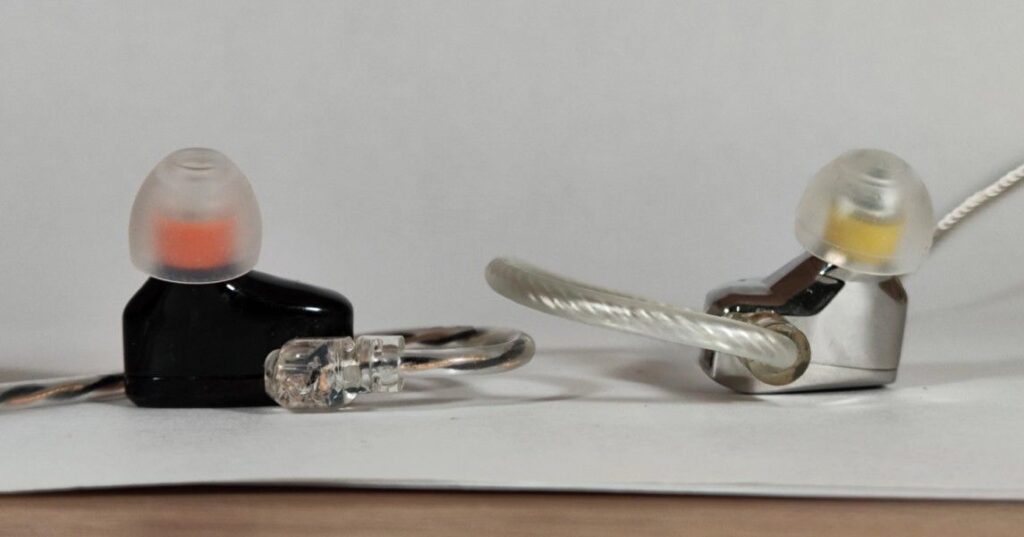
AMPLIFICATION
KATO
The Moondrop Kato is not difficult to drive. It sounds very good from both my old LGV40 and the POCO F5 (2023) phones’ 3.5mm jacks, with volume at +/- 70% with Tool’s Jambi. It’s even better from the THX Onyx and the AudioQuest Dragonfly Red USB dongles, with volume at around 50%.
My desktop rigs are hard to beat, but with the Kato, the difference is relatively small compared to the Onyx or Red. With regards to amplification, I thus consider the Moondrop Kato to be very versatile.
EM6L
My 2023 POCO F5 phone’s 3.5mm headphone output sounds really good with the EM6L, too, although the volume setting is typically 80–100%. It isn’t the last word in detail retrieval, but the tonality is excellent.
Not surprisingly, the THX Onyx USB dongle has more detail to offer than my phone, with the volume typically running 60–90%.
The AudioQuest Dragonfly Red sounds even better, adding some warmth and running at volume levels of 50–70%.
Even though the Topping A90 desktop amp sounds more dynamic and detailed than the dongles, it’s a bit dry.
The Class A Rebel Amp, however, sounds great. Definitely better than the Topping A90. It’s not a huge difference, but enough to make the EM6L more enjoyable.
The Ferrum Erco sounds even better with great tonal balance, precision, and dynamics.
The best results were with the Sparkos Labs Gemini tube hybrid amplifier. It sounds dynamic and detailed, but at the same time, it has an extra hint of midrange warmth and a more liquid sounding treble.
The EM6L scales well with the source and it pairs better with warmer-sounding upstream gear. It’s seemingly great with a good tube amp.
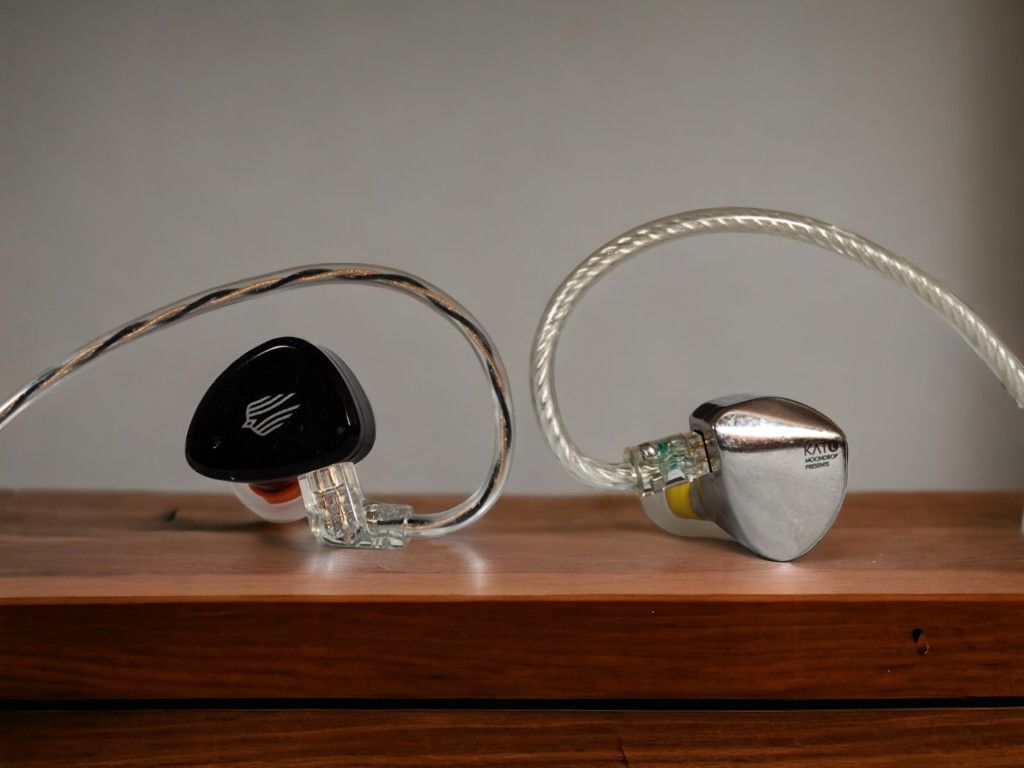
CONCLUSION
The Simgot EM6L and the Moondrop Kato share relatively similar frequency response curves, but they sound quite different.
The Kato is generally smoother and, at the same time, more detailed and refined. It falls short in soundstage size and imaging precision, where the EM6L is simply outstanding. Even though the EM6L has a clear treble, it’s a bit dry sounding, especially when compared to the Kato. It also has a thinner-sounding midrange. With warmer-sounding amps, though, both the treble and midrange get fuller and more organic, and the presentation gets slightly more similar to the Kato.
- Buy on Linsoul: Simgot EM6L
- Buy on Amazon: Simgot EM6L
- Buy on Linsoul: Moondrop Kato
- Buy on Amazon: Moondrop Kato
We make earnings through affiliate links and any purchase you make on Amazon or Linsoul clicking one of our links will give us a small provision at no cost to you.
We only get a provision for items that are not returned, so there’s no incentive for us to recommend something that’s not good.
Linsoul : Headphones, Earbuds, Wireless Earbuds, Desktop DAC/AMP, Portable DAC/AMP, Digital Audio Players,
Amazon: Headphones, IEMs, Headphone Amplifiers, Home Audio or Anything else.
.
If you enjoyed this article or other content on The Headphoneer, you might consider leaving a small donation to keep this website up and running. No donation is too small. Thanks for supporting us!
If you like our work please follow us on Instagram, Facebook and Twitter , it will help us grow. Sharing is caring 🙂


